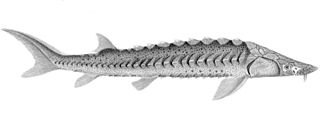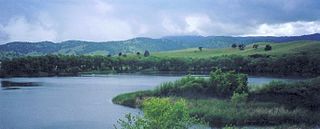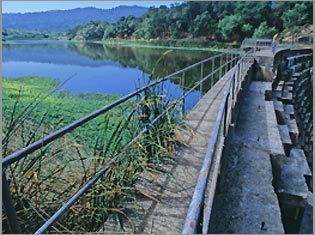
Smelts are a family of small fish, the Osmeridae, found in the North Atlantic and North Pacific Oceans, as well as rivers, streams and lakes in Europe, North America and Northeast Asia. They are also known as freshwater smelts or typical smelts to distinguish them from the related Argentinidae, Bathylagidae, and Retropinnidae.

Pink salmon or humpback salmon is a species of anadromous fish in the salmon family. It is the smallest and most abundant of the Pacific salmon. The scientific species name is based on the Russian common name for this species gorbúša (горбуша), which literally means humpie.

Hachirōgata or Hachirō Lagoon is a lake in Akita Prefecture in northern Japan. Its formal name is Lake Hachirō, but it is also called Hachirōgata Regulating Pond. At 4 meters below sea level, Hachirōgata is the lowest natural point in Japan.

The delta smelt is an endangered slender-bodied smelt, about 5 to 7 cm long, in the family Osmeridae. Endemic to the upper Sacramento-San Joaquin Estuary of California, it mainly inhabits the freshwater-saltwater mixing zone of the estuary, except during its spawning season, when it migrates upstream to fresh water following winter "first flush" flow events. It functions as an indicator species for the overall health of the Delta's ecosystem.

Hypomesus is a genus of smelts (Osmeridae), consisting of five species found in the northern hemisphere.

The longfin smelt is a smelt that is found in several estuaries and lakes along the northern Pacific coast of North America.

The broadfin sawtail catshark is a common species of catshark, part of the family Scyliorhinidae. It is found on or near the bottom at depths of 150–540 m (490–1,770 ft), from southeastern Japan to the East China Sea. A slender species growing to 68 cm (27 in) long, this shark is characterized by a fairly long, pointed snout, a series of indistinct, dark saddles along its back and tail, and a prominent crest of enlarged dermal denticles along the dorsal edge of its caudal fin. In addition, adult males have very long claspers that reach past the anal fin. The broadfin sawtail catshark is an opportunistic predator of bony fishes, cephalopods, and crustaceans, with immature and mature sharks being primarily piscivorous. It is oviparous and reproduces year-round.
San Leandro Creek is a 21.7-mile-long (34.9 km) year-round natural stream in the hills above Oakland in Alameda County and Contra Costa County of the East Bay in northern California.

The green sturgeon is a species of sturgeon native to the northern Pacific Ocean, from China and Russia to Canada and the United States.

The San Francisco Estuary together with the Sacramento–San Joaquin River Delta represents a highly altered ecosystem. The region has been heavily re-engineered to accommodate the needs of water delivery, shipping, agriculture, and most recently, suburban development. These needs have wrought direct changes in the movement of water and the nature of the landscape, and indirect changes from the introduction of non-native species. New species have altered the architecture of the food web as surely as levees have altered the landscape of islands and channels that form the complex system known as the Delta.

Lake Abashiri is a meromictic lake in Abashiri, Hokkaidō, Japan. It is located in Abashiri Quasi-National Park. The Abashiri and Memanbetsu Rivers flow into the lake. Water exits the lake through the Abashiri River again and flows 7 kilometres (4.3 mi) to the Sea of Okhotsk.
Freshwater smelt may refer to:
Japanese smelt may refer to:
Hypomesus pretiosus, or surf smelt, is a marine smelt with a range from Prince William Sound, Alaska to Long Beach, California, although its population declines south of San Francisco. The surf smelt grows to be about 10 inches in southern waters, and 83⁄4 inches in northern waters near Canada. On average, surf smelt weigh about 10 to the pound.

Marsh Creek is a stream in east Contra Costa County, California in Northern California which rises on the eastern side of Mount Diablo and flows 30 miles (48 km) to the Sacramento–San Joaquin River Delta at Oakley, California, near Big Break Regional Shoreline. The creek flows through Marsh Creek State Park (California), where water is impounded to form Marsh Creek Reservoir, then through the city of Brentwood, California.

Searsville Dam is a masonry dam in San Mateo County, California that was completed in 1892, one year after the founding of Stanford University, and impounds Corte Madera Creek to form a reservoir known as Searsville Lake. Searsville Dam is located in the Jasper Ridge Biological Preserve and is owned and operated by Stanford University. Neighboring cities include Woodside and Portola Valley, California.

Corte Madera Creek is a 7.3-mile-long (11.7 km) creek that flows north-northwest to Searsville Dam and then joins with Bear Creek to form San Francisquito Creek in California.

Peter B. Moyle is Distinguished Professor Emeritus in the Department of Wildlife, Fish and Conservation Biology and associate director of the Center for Watershed Sciences at the University of California, Davis. He has studied the ecology and conservation of fishes in freshwater and estuarine habitats in California (US) for over fifty years. He has a special interest in salmonid fishes and in the state’s highly endemic freshwater and estuarine fish fauna. Moyle has authored or co-authored more than 270 peer-reviewed publications, including 10 books, and over 225 other publications, including ca. 75 blogs.

Coreoperca kawamebari, commonly known as the Japanese perch, redfin perch, Japanese river perch, Eye-spot perch or in Anglophone parts of Japan, simply the perch, is a predatory species of the freshwater perch native to Japan and southern Korea. They are sometimes kept as pets. The Japanese perch are a member of the perch family but with the predatory feeding behaviour of the black bass (Micropterus) and bluegill.
Sacramento–San Joaquin is a freshwater ecoregion in California. It includes the Sacramento and San Joaquin river systems of California's Central Valley, which converge in the inland Sacramento–San Joaquin Delta. It also includes the mostly-closed Tulare Lake basin in the southern Central Valley, the rivers and streams that empty into San Francisco Bay, and the Pajaro and Salinas river systems of Central California which empty into Monterey Bay.
















